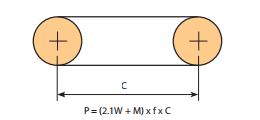Introduction
A cautious evaluation of your ailments surrounding a conveyor is important for correct conveyor chain choice. This part discusses the essential concerns necessary for successful conveyor chain variety. Roller Chains are sometimes utilised for light to reasonable duty material handling applications. Environmental disorders may possibly demand the usage of particular resources, platings coatings, lubricants or the ability to operate with out supplemental external lubrication.
Simple Information Necessary For Chain Choice
? Type of chain conveyor (unit or bulk) like the approach of conveyance (attachments, buckets, as a result of rods and so on).
? Conveyor layout including sprocket spots, inclines (if any) along with the quantity of chain strands (N) to get utilised.
? Amount of material (M in lbs/ft or kN/m) and style of materials for being conveyed.
? Estimated bodyweight of conveyor components (W in lbs/ft or kN/m) including chain, slats or attachments (if any).
? Linear chain pace (S in ft/min or m/min).
? Environment in which the chain will operate such as temperature, corrosion circumstance, lubrication issue etc.
Stage 1: Estimate Chain Tension
Utilize the formula beneath to estimate the conveyor Pull (Pest) after which the chain tension (Check). Pest = (M + W) x f x SF and
Check = Pest / N
f = Coefficient of Friction
SF = Speed Element
Step 2: Make a Tentative Chain Choice
Making use of the Check value, make a tentative choice by picking a chain
whose rated operating load better than the calculated Check worth.These values are suitable for conveyor service and are diff erent from individuals proven in tables with the front with the catalog that are associated with slow pace drive chain utilization.
Additionally to suffi cient load carrying capacity usually these chains need to be of  the sure pitch to accommodate a wanted attachment spacing. For instance if slats are to become bolted to an attachment each 1.five inches, the pitch with the chain selected ought to divide into one.5?¡À. Thus one could use a forty chain (1/2?¡À pitch) together with the attachments every single 3rd, a 60 chain (3/4?¡À pitch) using the attachments just about every 2nd, a 120 chain (1-1/2?¡À pitch) using the attachments each pitch or maybe a C2060H chain (1-1/2?¡À pitch) using the attachments just about every pitch.
the sure pitch to accommodate a wanted attachment spacing. For instance if slats are to become bolted to an attachment each 1.five inches, the pitch with the chain selected ought to divide into one.5?¡À. Thus one could use a forty chain (1/2?¡À pitch) together with the attachments every single 3rd, a 60 chain (3/4?¡À pitch) using the attachments just about every 2nd, a 120 chain (1-1/2?¡À pitch) using the attachments each pitch or maybe a C2060H chain (1-1/2?¡À pitch) using the attachments just about every pitch.
Stage three: Finalize Selection – Determine Real Conveyor Pull
Immediately after making a tentative selection we need to confirm it by calculating
the actual chain tension (T). To do this we need to fi rst determine the real conveyor pull (P). In the layouts shown around the suitable side of this webpage select the suitable formula and determine the total conveyor pull. Note that some conveyors could be a mixture of horizontal, inclined and vertical . . . in that case determine the conveyor Pull at each section and add them together.
Stage four: Determine Highest Chain Stress
The utmost Chain Tension (T) equals the Conveyor Pull (P) as calculated in Step 3 divided by the variety of strands carrying the load (N), instances the Pace Aspect (SF) shown in Table 2, the Multi-Strand Element (MSF) proven in Table 3 as well as the Temperature Aspect (TF) proven in Table 4.
T = (P / N) x MSF x SF x TF
Phase five: Verify the ?¡ãRated Operating Load?¡À on the Selected Chain
The ?¡ãRated Functioning Load?¡À of the chosen chain should really be higher compared to the Maximum Chain Tension (T) calculated in Stage 4 over. These values are suitable for conveyor services and therefore are diff erent from these proven in tables at the front from the catalog which are associated with slow pace drive chain usage.
Step six: Check out the ?¡ãAllowable Roller Load?¡À from the Chosen Chain
For chains that roll to the chain rollers or on major roller attachments it can be essential to check the Allowable Roller Load?¡À.
Note: the Roller load is determined by:
Roller Load = Wr / Nr
Wr = The total excess weight carried through the rollers
Nr = The number of rollers supporting the weight.
